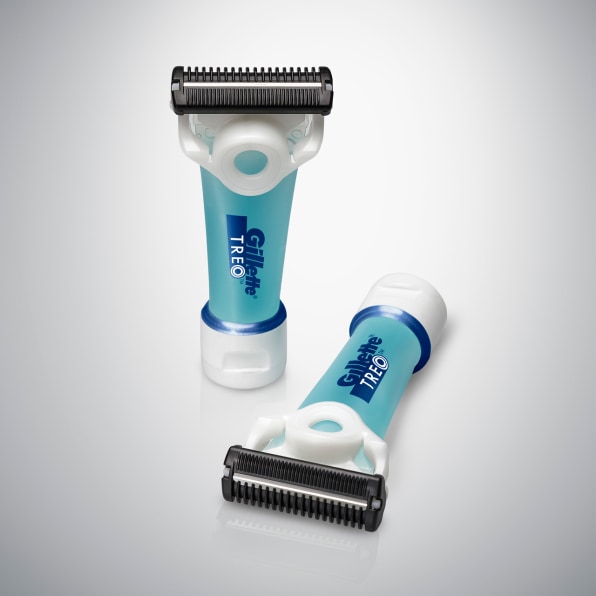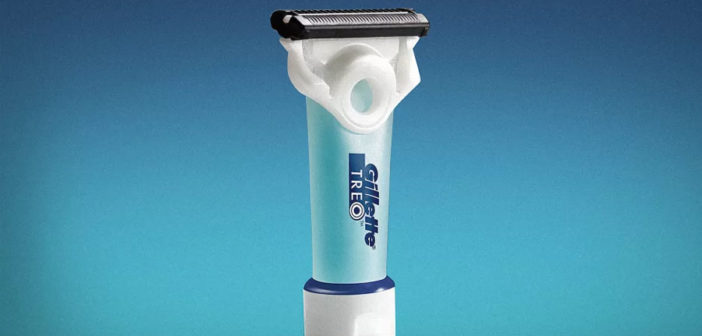Treo, a masterpiece of inclusive design, is a finalist in the 2018 Innovation by Design awards.
Gillette has been designing razors since 1900–but they’re all designed for you to shave yourself. There’s another group of people who want to be shaved and rely on other people to do it for them: the elderly and people with disabilities. For caretakers, shaving someone else is a nerve-wracking process that requires navigating a lot of awkward angles with the constant fear of accidentally cutting them.
In 2017, Gillette began testing Treo, its first ever assistive shaving razor designed specifically to alleviate the challenges of shaving someone else. Treo, which is a finalist in the 2018 Innovation by Design awards, fuses a razor blade with tube of shaving gel that serves as its handle and gives shavers more control while keeping the mess to a minimum. For elderly men who can no longer shave themselves, it’s a product that can help them maintain a clean appearance and preserve a semblance of their youth.
“Shaving in that context is a massive part of those men’s dignity,” says Matt Hodgson, a principal design engineer at Gillette’s product development facility in the U.K. who led design for Treo. “It’s something they’ve done all the way through their lives.”
Treo is an example of inclusive design at its best–and it originated from feedback Gillette began to hear from its users. While many of the company’s advertising campaigns focus on the moment a father teaches his son how to shave, Gillette had started to get feedback on social media about what happens when a father no longer can shave himself. The verdict? None of its razors were designed to help.
To understand why it was so hard to shave someone else, Hodgson started by shaving a colleague in the office. Once he tried it, Hodgson realized just how difficult it was to do: unlike when you shave yourself, it’s hard to tell if you’re applying enough pressure to effectively cut the hairs while not inadvertently cutting the skin. And if shaving those tricky spots is onerous when you’re doing it yourself, it’s even worse when you’re doing it for someone else.
Hodgson also traveled to a local nursing home to observe assisted shaving in the wild. “I watched three guys being shaved,” he says. “It was something I’ll never forget. I sat there thinking, we can do so much better than this. In addition to all the problems I was finding, there were so many more in that situation, particularly when you’re shaving someone who’s in a vulnerable position.”

It wasn’t just that it was challenging to know how much pressure to apply to someone else’s skin to get the job done. The circumstances of shaving were entirely different too: Men were usually shaved sitting down or in bed rather than in the shower, meaning there wasn’t immediate access to water to wash off the razor. That also meant that using standard shaving cream would quickly become a mess. Because the person being shaved is typically in a seated or reclined position, shavers also needed to hold the razor at a different angle to get a close shave.
Hodgson and his team developed a series of five different prototypes over three months, returning to the nursing home with dozens of test razors for the caregivers to try out, before arriving at the final design. To tackle the problem of shaving occurring outside of the bathroom and away from a running tap, Hodgson added a special razor guard that was initially designed for the Indian market, where men’s hair is thicker and they tend to use less water when shaving. Whereas Hodgson had originally observed caregivers going through two or three disposable razors for a single shave in the nursing home, the guard helped with clogging and enabled shavers to do the whole face using a single razor. Treo’s handle doubles as a tube of water-based gel, developed to go onto the skin cleanly without creating the kind of mess that shaving cream would–an imperative for shaving that’s happening outside the bathroom. Hodgson also reoriented the angle between the razor head and this tube handle so that shavers can hold the device like a paintbrush or a pencil, giving them more control.
In the fall of 2017, Gillette began sending out this final design for free to nursing homes and individuals across the United States and U.K. as part of a pilot program. During testing, the team had primarily focused on professional carers who were shaving multiple men on a daily basis, but they wanted to know if the product would work for people in different situations. One pilot tester was Anne Baker, a woman who shaves her husband who has Parkinson’s about once a month before important events. “He was military. He was an executive. He always put his best face forward. His appearance was incredibly important to him,” Baker says.
She’s found Treo to be the answer to her fear over cutting her husband while trying to shave him, and wishes it had been around when her father–who worked for Gillette–was old. “This would have been a godsend when he was quite old and in a nursing home,” she says. “He would have loved this. He always wanted to be clean-shaven.”
Armed with positive feedback from the pilot, Gillette has started selling razors to a limited number of people through its website as it assesses whether to bring Treo to the mainstream. “We know the shave business inside out, better than anybody else,” Hodgson says. “But this was a completely different market.”
–
This article first appeared in www.fastcompany.com
Seeking to build and grow your brand using the force of consumer insight, strategic foresight, creative disruption and technology prowess? Talk to us at +9714 3867728 or mail: info@groupisd.com or visit www.groupisd.com

